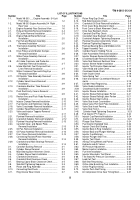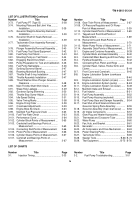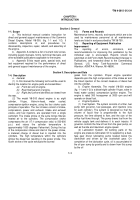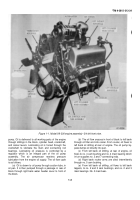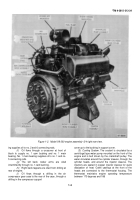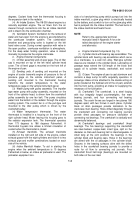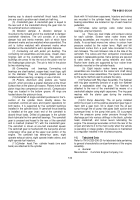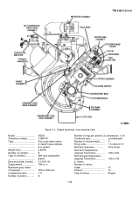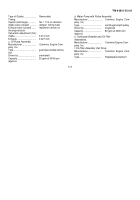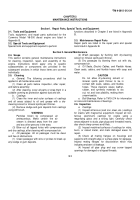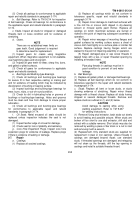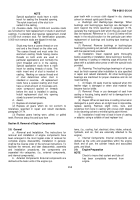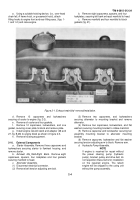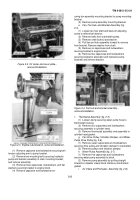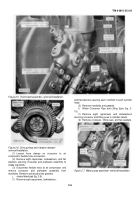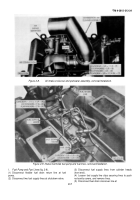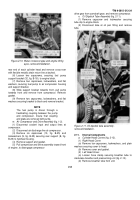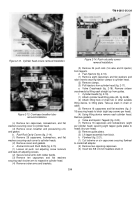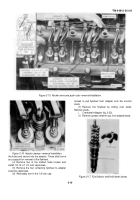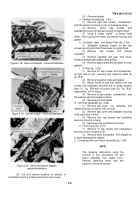TM-9-2815-213-34 - Page 17 of 192
*TM 9-2815-213-34
(5) Check all castings for conformance to applicable
repair and rebuild standards in paragraph 3-174.
b.
Ball Bearings.
Refer to TM 9-214 for inspection
of ball bearings. Check all bearings for conformance to
the applicable repair and rebuild standards in paragraph
3-174.
c. Studs.
Inspect all studs for stripped or damaged
threads, bent or loose condition and for evidence of
stretching.
d.
Gears.
NOTE
There are no established wear limits on
gear teeth. Good judgement is required
to determine need for replacement.
(1) Inspect gears for cracks using magnaflux
equipment. When magnaflux equipment is not available,
use magnifying glass and strong light.
(2) Inspect all gear teeth for wear, sharp fins, burrs,
and galled or pitted surfaces.
(3) Check all gears for conformance to applicable
repair and rebuild standards.
e.
Bushings and Bushing-type Bearings.
(1) Check all bushings and bushing-type bearings
for secure fit in their respective casting or mating part
and for evidence of heating which may be indicated by
discoloration of bushing or bearing surface.
(2) Inspect bushings and bushing-type bearings for
wear, burrs, nicks, or out-of-round condition.
(3) Check for dirt in lubricating holes or grooves of
bushings or bushing-type bearings. Holes and grooves
must be clean and free from damage to insure proper
lubrication.
(4) Check all bushings and bushing-type bearings
for conformance to applicable repair and rebuild
standards in paragraph 3-174.
f.
Oil Seals.
Metal encased oil seals should be
replaced unless inspection indicates the seal is not
damaged.
(1) Inspect feather edge of oil seal for damage.
(2) Check seal for loss of pliability and resiliency.
g.
Core Hole Expansion Plugs.
Inspect core hole
expansion plugs for evidence of leakage. Replace plugs
if there is evidence of leaking or damage.
2-7.
Repair
a.
Castings.
(1) Replace all cracked castings.
(2) Replace all castings which do not conform to
tolerances specific, repair and rebuild standards in
paragraph 3-174
(3) Repair minor damage to machined surfaces with
a fine mill file or crocus cloth dipped in dry-cleaning
solvent or mineral spirits paint thinner. Replace all
castings on which machined surfaces are burred or
nicked to the point of impairing subsequent assembly or
operation.
(4) Repair minor warpage of mounting flanges and
gasket surfaces by working surface across a sheet of
crocus cloth held tightly on a surface plate or similar flat
surface. Replace castings having flanges which are
warped to the point of impairing assembly or operation.
(5) Repair damaged pipe or cap screw threads in
tapped holes with a tap, or repair threaded opening by
installing a threaded insert.
NOTE
Pipe plug threads in castings must be in
good condition to prevent oil and water
leakage.
b.
Ball Bearings.
(1) Replace all galled, pitted, or damaged ball bearings.
(2) Replace all ball bearings which do not conform to
tolerances specified in the repair and rebuild standards
in paragraph 3-174.
c.
Studs.
Replace all bent or loose studs, or studs
showing evidence of stretching. Repair minor thread
damage with a thread chaser. Replace all studs having
stripped or several damaged threads. Remove and
replace studs as outlined in (1) and (2) below.
CAUTION
Avoid damage to casting while using
welding equipment. Refer to TM 9-237
for welding instructions.
(1)
Removal.
Using stud extractor, back studs out slowly
to avoid heating and possible seizure. When studs are
broken off too short to use stud extractor, drill stud and
extract with a suitable remover. Short studs may also be
removed by welding a piece of bar stock or a nut to stud
and removing it with a wrench.
(2)
Replacement.
Only standard studs are supplied for
replacement in steel or iron castings. Unless threads in
castings are damaged beyond repair, use standard
studs. If threaded openings are damaged and retapping
will not clean up the threads, drill the tap opening in
castings and install a suitable threaded insert.
2-2
Back to Top

